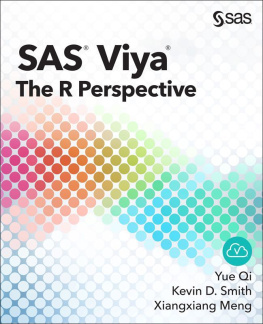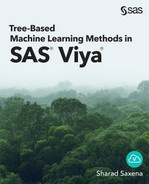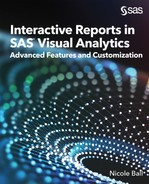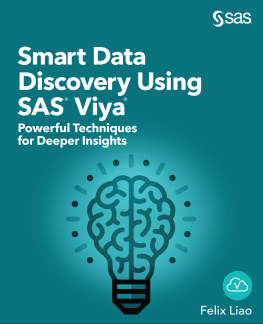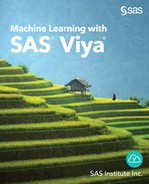Yue Qi - SAS Viya: The R Perspective
Here you can read online Yue Qi - SAS Viya: The R Perspective full text of the book (entire story) in english for free. Download pdf and epub, get meaning, cover and reviews about this ebook. year: 2018, publisher: SAS Institute, genre: Romance novel. Description of the work, (preface) as well as reviews are available. Best literature library LitArk.com created for fans of good reading and offers a wide selection of genres:
Romance novel
Science fiction
Adventure
Detective
Science
History
Home and family
Prose
Art
Politics
Computer
Non-fiction
Religion
Business
Children
Humor
Choose a favorite category and find really read worthwhile books. Enjoy immersion in the world of imagination, feel the emotions of the characters or learn something new for yourself, make an fascinating discovery.
- Book:SAS Viya: The R Perspective
- Author:
- Publisher:SAS Institute
- Genre:
- Year:2018
- Rating:5 / 5
- Favourites:Add to favourites
- Your mark:
- 100
- 1
- 2
- 3
- 4
- 5
SAS Viya: The R Perspective: summary, description and annotation
We offer to read an annotation, description, summary or preface (depends on what the author of the book "SAS Viya: The R Perspective" wrote himself). If you haven't found the necessary information about the book — write in the comments, we will try to find it.
SAS Viya: The R Perspective — read online for free the complete book (whole text) full work
Below is the text of the book, divided by pages. System saving the place of the last page read, allows you to conveniently read the book "SAS Viya: The R Perspective" online for free, without having to search again every time where you left off. Put a bookmark, and you can go to the page where you finished reading at any time.
Font size:
Interval:
Bookmark:
The correct bibliographic citation for this manual is as follows: Qi, Yue, Kevin D. Smith, and Xiangxiang Meng. 2018. SASViya: The R Perspective. Cary, NC: SAS Institute Inc. SASViya: The R Perspective Copyright 2018, SAS Institute Inc., Cary, NC, USA ISBN 978-1-63526-704-4 (Hard copy) ISBN 978-1-63526-701-3 (EPUB) ISBN 978-1-63526-702-0 (MOBI) ISBN 978-1-63526-703-7 (PDF) All Rights Reserved.
Produced in the United States of America. For a hard copy book: No part of this publication may be reproduced, stored in a retrieval system, or transmitted, in any form or by any means, electronic, mechanical, photocopying, or otherwise, without the prior written permission of the publisher, SAS Institute Inc. For a web download or e-book: Your use of this publication shall be governed by the terms established by the vendor at the time you acquire this publication. The scanning, uploading, and distribution of this book via the Internet or any other means without the permission of the publisher is illegal and punishable by law. Please purchase only authorized electronic editions and do not participate in or encourage electronic piracy of copyrighted materials. U.S. U.S.
Government License Rights; Restricted Rights: The Software and its documentation is commercial computer software developed at private expense and is provided with RESTRICTED RIGHTS to the United States Government. Use, duplication, or disclosure of the Software by the United States Government is subject to the license terms of this Agreement pursuant to, as applicable, FAR 12.212, DFAR 227.7202-1(a), DFAR 227.7202-3(a), and DFAR 227.7202-4, and, to the extent required under U.S. federal law, the minimum restricted rights as set out in FAR 52.227-19 (DEC 2007). If FAR 52.227-19 is applicable, this provision serves as notice under clause (c) thereof and no other notice is required to be affixed to the Software or documentation. The Governments rights in Software and documentation shall be only those set forth in this Agreement. product or service names are registered trademarks or trademarks of SAS Institute Inc. in the USA and other countries. indicates USA registration. indicates USA registration.
Other brand and product names are trademarks of their respective companies. SAS software may be provided with certain third-party software, including but not limited to open-source software, which is licensed under its applicable third-party software license agreement. For license information about third-party software distributed with SAS software, refer to http://support.sas.com/thirdpartylicenses. Contents About This Book
Of course, in this book we focus on the perspective of SAS Viya from R. SAS Viya consists of multiple components. The central piece of this ecosystem is SAS Cloud Analytic Services (CAS). CAS is the cloud-based server that all clients communicate with to run analytical methods. The R client is used to drive the CAS component directly using objects and constructs that are familiar to R programmers. We assume that you have some knowledge about R before you approach the topics in this book.
We do not assume any knowledge of CAS itself. However, you must have a CAS server that is set up and is running in order to execute the examples in this book. The chapters in the first part of the book cover topics from the installation of R to the basics of connecting, loading data, and getting simple analyses from CAS. Depending on your familiarity with R, after reading the Ten-Minute Guide to Using CAS from R, you might feel comfortable enough to jump to the chapters later in the book that are dedicated to statistical methods. However, the chapters in the middle of the book cover more detailed information about working with CAS, such as constructing action calls to CAS and processing the results, error handling, managing your data in CAS, and using object interfaces to CAS actions and CAS data tables. Finally, the last chapter about advanced topics covers features and workflows that you might want to take advantage of when you are more experienced with the R client.
This book covers topics that are useful to complete beginners, as well as to experienced CAS users. Its examples extend from creating connections to CAS to simple statistics and machine learning. The book is also useful as a desktop reference.
If you do not know R, there is a multitude of resources on the internet for learning R. The later chapters in the book cover data analysis and modeling topics. Although the examples provide step-by-step code walk-throughs, some training about these topics beforehand is helpful.
Various R resources and packages were used as well. SWAT works with many versions of these packages. The URLs of SWAT and other resources are shown as follows: SAS Viya
www.sas.com/en_us/software/viya.html SAS Scripting Wrapper for Analytics Transfer (SWAT) R client to CAS github.com/sassoftware/R-swat (GitHub repository) R https://www.r-project.org/ RStudio an integrated development environment (IDE) for R https://www.rstudio.com/
SAS has many resources to help you find answers and expand your knowledge. If you need additional help, see our list of resources: sas.com/books. About These Authors  Yue Qi, PhD, is a staff scientist at SAS. He works on automated and adaptive machine learning pipelines, deep learning models on unstructured data, interactive data visualization, and open-source language integration. He has extensive experience in applying these technologies to develop analytics products, build successful models on big data for customers, and help customers solve their most challenging business problems, especially in the finance industry.
Yue Qi, PhD, is a staff scientist at SAS. He works on automated and adaptive machine learning pipelines, deep learning models on unstructured data, interactive data visualization, and open-source language integration. He has extensive experience in applying these technologies to develop analytics products, build successful models on big data for customers, and help customers solve their most challenging business problems, especially in the finance industry. 
Font size:
Interval:
Bookmark:
Similar books «SAS Viya: The R Perspective»
Look at similar books to SAS Viya: The R Perspective. We have selected literature similar in name and meaning in the hope of providing readers with more options to find new, interesting, not yet read works.
Discussion, reviews of the book SAS Viya: The R Perspective and just readers' own opinions. Leave your comments, write what you think about the work, its meaning or the main characters. Specify what exactly you liked and what you didn't like, and why you think so.

